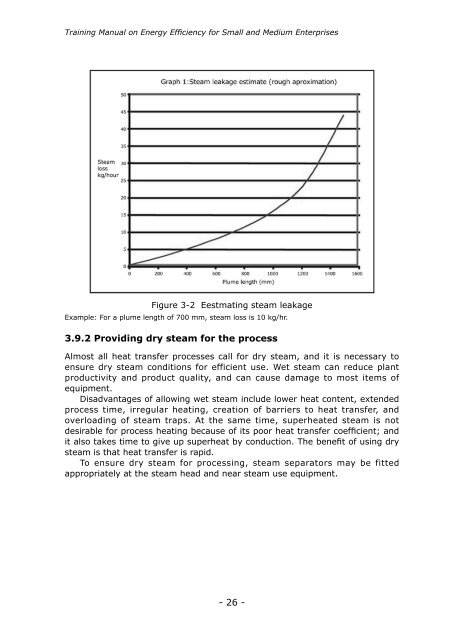Training Manual on Energy Efficiency - APO Asian Productivity ...
Training Manual on Energy Efficiency - APO Asian Productivity ...
Training Manual on Energy Efficiency - APO Asian Productivity ...
You also want an ePaper? Increase the reach of your titles
YUMPU automatically turns print PDFs into web optimized ePapers that Google loves.
<str<strong>on</strong>g>Training</str<strong>on</strong>g> <str<strong>on</strong>g>Manual</str<strong>on</strong>g> <strong>on</strong> <strong>Energy</strong> <strong>Efficiency</strong> for Small and Medium Enterprises<br />
Figure 3-2 Eestmating steam leakage<br />
Example: For a plume length of 700 mm, steam loss is 10 kg/hr.<br />
3.9.2 Providing dry steam for the process<br />
Almost all heat transfer processes call for dry steam, and it is necessary to<br />
ensure dry steam c<strong>on</strong>diti<strong>on</strong>s for efficient use. Wet steam can reduce plant<br />
productivity and product quality, and can cause damage to most items of<br />
equipment.<br />
Disadvantages of allowing wet steam include lower heat c<strong>on</strong>tent, extended<br />
process time, irregular heating, creati<strong>on</strong> of barriers to heat transfer, and<br />
overloading of steam traps. At the same time, superheated steam is not<br />
desirable for process heating because of its poor heat transfer coefficient; and<br />
it also takes time to give up superheat by c<strong>on</strong>ducti<strong>on</strong>. The benefit of using dry<br />
steam is that heat transfer is rapid.<br />
To ensure dry steam for processing, steam separators may be fitted<br />
appropriately at the steam head and near steam use equipment.<br />
- 26 -
















